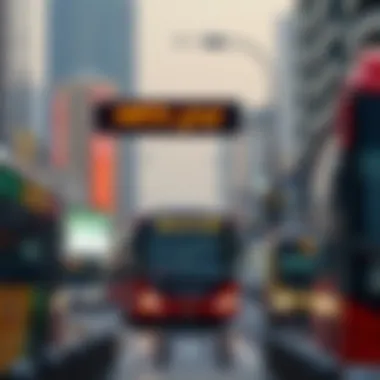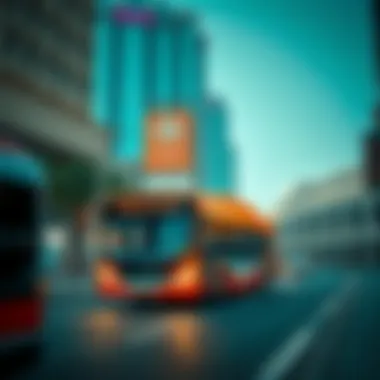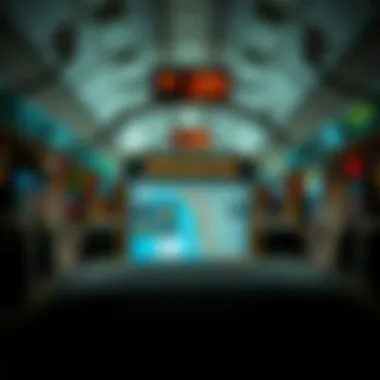Navigating the Dubai Bus Map: A Complete Guide


Intro
Navigating a bustling metropolis like Dubai can be as daunting as a camel race in the desert. The Dubai bus map serves as a vital resource for countless residents and visitors, especially those looking to explore the city while also considering residential and investment opportunities. With such a sprawling urban layout, the bus network not only facilitates public transport but also plays a significant role in connecting communities and influencing real estate values.
The bus system is more than just a collection of routes; it’s intricately woven into the urban fabric of Dubai. Understanding how this network operates can help identify which neighborhoods may offer better connectivity and amenities, ultimately guiding property decisions.
It's crucial for expats and investors to grasp not only the logistical aspects of the transportation system but also the social dynamics at play. This isn’t just about where to catch a bus; it's about weaving yourself into the lifestyle and opportunities that line those bus routes.
In this guide, we will delve into various factors, including property investment insights, living conditions, and how the bus network integrates with other forms of transportation in Dubai. By brushing up on these elements, investors can make more informed choices about where to plant their roots or where to put their money.
Overview of Dubai's Public Transportation Network
Dubai’s vibrant public transportation network stands as a pillar of its urban planning and development strategy. It serves not only the daily commuters but also tourists and expatriates, creating a finely woven tapestry of movement through one of the fastest-growing cities in the world. Understanding this network is essential for anyone looking to live or invest in Dubai. This article aims to demystify the city's transport system, particularly highlighting the bus services that interlink various neighborhoods, priorities in real estate, and overall urban mobility.
Importance of Public Transport in Urban Areas
Public transport in urban areas like Dubai is crucial for a myriad of reasons. First, it provides a cost-effective means of getting from point A to point B, which can be especially beneficial for expatriates and local workers. Efficient public transport also reduces the number of cars on the road, easing traffic congestion and aiding environmental sustainability. In cities where high-density living is prevalent, such as Dubai, a reliable public transport system encourages a shift away from personal car use, fostering a community-oriented lifestyle. It creates a web of connections that can positively influence property values, as homes near transit lines often enjoy increased demand. Ultimately, an effective public transport network is indispensable in crafting a city’s infrastructure and fostering connectivity among residents.
Types of Public Transport Available
Dubai boasts a multifaceted public transportation network that includes buses, metros, trams, and water taxis. This variety caters to a wide range of commuter preferences and needs.
Buses
Buses in Dubai are often regarded as highly accessible and a practical option for many. They cover vast areas across the emirate, reaching destinations that might not be directly accessible via the metro. One of the key characteristics of Dubai's bus system is its extensive coverage, which includes over 100 routes. This not only offers convenience but also flexibility in travel schedules. The buses are equipped with modern amenities and are an affordable choice for daily commutes.
However, the reliance on buses may come with one caveat—time efficiency. While buses serve as a comprehensive form of transport, they are sometimes subject to road traffic, which can delay travel times compared to the metro. For those looking to navigate the full expanse of Dubai, buses remain a crucial cog in the public transport mechanism.
Metro
The metro system in Dubai is a cornerstone of urban transport and is characterized by its speed and efficiency. Running two main lines (Red and Green), the metro connects significant regions of the city, from the bustling Dubai Marina to the iconic Dubai Mall. The most notable aspect of the metro is its punctuality and low waiting times, which are enviable compared to other modes of transport.
It offers a unique feature: the driverless system, ensuring safety while allowing for a seamless riding experience. While the metro is favored for convenience, it may not reach every corner of the city, making knowledge of bus connections crucial for complete coverage.
Trams
Trams add another layer to Dubai’s public transport landscape. Serving primarily the area of Dubai Marina and Jumeirah Lakes Towers, trams are practical for short distances. One key characteristic of the tram system is its integration with the metro, allowing for easy transfers. This connectivity enhances overall urban transit experience, simplifying out-and-about journeys.
However, the tram network currently serves a limited area, so while they are great for quick hops within certain districts, they are less ideal for longer journeys. Still, they are an aesthetic addition to the city, with tracks that blend into the architecture around them, making the commute visually pleasing.
Water Taxis
A unique aspect of Dubai's transport offerings is its water taxis. These play an essential role, particularly for those residing near the coastline. While you might not think water transport when considering commuting options, this service connects various points along the Dubai Creek and coastline. One major advantage is how it offers a scenic ride, bypassing some of the typical traffic woes.
Nonetheless, the downside is that its routes may not always serve those deep within the city's periphery, making it a mode of transport suited more for leisure or occasional trips than daily commuting. Thus, water taxis bring both charm and functional mobility to the urban transport landscape.
Overall, understanding the intricacies of Dubai's public transport system, particularly the bus routes, is not only essential for efficient commuting but also serves as a significant factor in real estate decisions. This multi-tiered transport model reveals a holistic approach to urban planning, ultimately aiming to enhance the mobility experience in a rapidly evolving metropolis.
Understanding the Dubai Bus Map
Understanding the bus map is essential for anyone navigating through Dubai’s vibrant public transportation system. The bus network plays a crucial role in connecting various parts of the city, offering a feasible alternative for both residents and visitors. This section aims to outline the bus map's significance, highlighting its benefits for commuters, real estate investors, and newcomers who may find this city both exciting and overwhelming.


The layout of the bus map is not just a mere depiction of lines and stops; it represents a lifeline for individuals seeking efficient travel options. Given the rapid urbanization of Dubai, public transport systems are increasingly vital. For homebuyers and investors, the proximity of bus routes to properties can significantly influence property values and desirability.
Layout and Design Features
The design of the Dubai bus map is structured to highlight its utility and ensure ease of use. Each bus route is strategically plotted with clear demarcations, reflecting the city's extensive network. The layout is intuitive, making it easier for users to locate bus stops and understand the connections available.
Various elements form part of the visual approach to the map, from the size of the bus icons to the clarity of the bus route lines. Notably, the map is sectioned into urban areas, highlighting major neighborhoods and commercial districts. The markings are easy to spot, directing users to key destinations within Dubai, including educational institutions and healthcare facilities.
In short, the design aims to facilitate quick understanding, helping both seasoned commuters and newcomers find their way around the city with minimal fuss, making their daily travels efficient.
Color Coding and Symbols Explained
Color coding plays a pivotal role in the Dubai bus map, providing instant visual cues that enhance user experience. Each bus route is represented with distinct colors, creating a quick reference for users to identify their desired bus line at a glance. For instance, the red routes may signify local buses, while blue could represent those catering to long-distance travel.
Symbols present on the map also carry essential meanings. For instance, a circle icon often marks the bus stop, while a square might indicate transfer hubs where users can switch to other modes of transport, like the Metro.
Such categorization simplifies navigation, ensuring users can plan their trips effectively without delving too deeply into the intricacies of route planning. Each symbol and color choice reflects a commitment to an efficient public transport experience,
Key Bus Routes Overview
Having a grasp on the key bus routes is indispensable for anyone looking to understand the dynamics of public transport in Dubai. Major routes link high-demand areas like shopping districts, business centers, and cultural sites. For example, Route 8 famously connects the bustling Mall of the Emirates with Al Quoz and beyond, allowing access to lively districts in no time.
Moreover, routes serving popular locations such as Jumeirah Beach, major hotels, and international airports enhance the city's accessibility.
In addition, many of these bus routes synchronize with Metro stations, maximizing connectivity options. This is particularly beneficial for expatriates or investors looking for properties near vibrant hubs.
Understanding these key routes equips users with the knowledge they need not only for efficient travel but also insight into property values and the overall livability of specific neighborhoods.
In sum, the bus map provides vital information that transcends mere navigation; it forms an integral aspect of urban life in Dubai, shaping daily commutes while impacting broader trends in real estate and community development.
Key Bus Routes and Destinations
Navigating the urban landscape of Dubai without a clear understanding of the bus routes can feel like trying to read the stars without a map. The city's bus network is an essential artery of public transportation, connecting various neighborhoods, shopping outlets, and cultural landmarks. Knowing the key bus routes not only facilitates easier movement across the city but also empowers real estate investors and newcomers alike. When considering property investments, proximity to these routes could influence daily commutes and thus, property values. Understanding the connections and routes can guide informed decisions, ensuring that investors target properties in desirable locations with favorable transport accessibility.
High-Demand Routes
In a city that is constantly on the move, certain bus routes see a higher volume of riders. These high-demand routes are essential for commuter travel throughout the city. They typically connect major residential areas to business districts, which is crucial for professionals who rely on public transport for their daily commute.
Consider the Route 8, which connects the bustling area of Deira with the financial hubs of Dubai World Trade Center and Dubai Internet City. This route is pivotal, especially during the morning and evening rush hours, as it serves a wide array of commuters, from office workers to tourists eager to explore the vibrant city.
The advantage of these routes is their frequency and coverage. They run often, minimizing wait times and making it easier for users to plan their day. However, with increased demand comes the occasional overcrowding, especially during peak hours.
Connections to Major Landmarks
The bus routes in Dubai offer a robust link to major landmarks, ensuring that residents and visitors can access key areas with ease. Understanding these connections is vital for anyone looking to explore the city or make informed real estate investments.
Shopping Malls
Dubai is famous for its extravagant shopping malls, and bus routes ensure that these commercial hubs are accessible to everyone. Take the Route 30, for instance, which directly services the Dubai Mall, one of the largest shopping centers in the world. The accessibility from various neighborhoods makes it a popular choice for shoppers and tourists alike.
One key characteristic of these shopping malls is their integration with the bus system. This easily connects people to entertainment and dining options, boosting foot traffic. However, a downside could be the congestion around mall areas, particularly during weekends when footfall peaks.
Business Hubs


Navigating to business hubs like the Dubai International Financial Centre (DIFC) and Jumeirah Lakes Towers (JLT) is made significantly easier by dedicated bus routes. The Route 66, which goes through these essential economic zones, offers a direct path for those working in high-stakes jobs.
These business hubs are known for their modern facilities and networking opportunities. Due to their strategic locations and the easy access provided by the bus system, they tend to attract professionals and businesses. While property values in these areas are generally higher, the ease of access might justify the investment for many.
Cultural Sites
Cultural enrichment is a vital part of Dubai's identity, and bus routes serve as a bridge to major cultural sites. Consider the significance of Route 40, which connects to the Dubai Opera and the Dubai Museum. This route is instrumental for both tourists and locals seeking to engage with Dubai's diverse cultural offerings.
The unique feature of these cultural sites is their ability to attract crowds for art exhibitions, performances, and heritage festivals. The bus system facilitates seamless transit to these events, enhancing their accessibility. However, potential challenges can arise during major events, as buses may be rerouted or crowded, which could inconvenience visitors.
In summary, understanding the critical bus routes that connect to shopping malls, business hubs, and cultural sites elevates the overall experience of living in or visiting Dubai. It presents essential insights for investors regarding property values and connectivity in relation to significant destinations throughout the city. For more detailed maps and route information, you may want to visit the RTA official site or refer to information available on sites like Wikipedia.
Remember: Proximity to well-connected bus routes could dramatically affect the desirability and property value in Dubai's real estate market.
Navigating the Bus System Effectively
Navigating the bus system in Dubai may seem daunting at first, particularly for those who are new to the city or its public transport services. However, understanding the nuances of the bus network can turn a complicated journey into a smooth ride. This section aims to empower readers with practical knowledge that enhances their commuting experience, making it not just easier, but also more efficient.
Tips for First-Time Users
For anyone stepping onto a Dubai bus for the first time, having a game plan can make all the difference. Here are some key pointers:
- Know Your Route: Before heading out, it's wise to check the bus map and know which route you need. Websites like RTA Dubai provide interactive maps that can help.
- Timing is Everything: Buses might not always run like clockwork, especially in busy hours. Making a note of the bus schedule can be beneficial. Look out for the bus frequency; certain high-demand routes will have more buses running.
- Don’t Overpack: While lots of shopping bags or bulky luggage might feel convenient, they can really cramp your style and disturb fellow passengers. Try to travel light when you can.
"Preparation is the key to success."
Using Mobile Apps and Tools
In this digital age, mobile apps can be your best ally when navigating the Dubai bus system. Some popular tools include:
- RTA Smart App: This is a go-to resource for public transportation in Dubai, providing real-time bus arrival times, route options, and fare information.
- Google Maps: It might not be the local favorite, but it includes public transportation options in its directions. Input your destination, and you’ll get detailed route information.
- Dubai Bus Timetable: While not an app, having a digital or printed timetable can save time and hassle. Available via the RTA website, this tool helps you plan your journey based on specific routes and times.
Payment Systems and Fare Structure
Understanding how to pay for your ride is equally vital. Dubai uses a unified fare system for all public transport modes, including buses. Here’s how it works:
- Nol Card: This smart card is a must-have for residents and visitors alike. It can be used on buses, the metro, and trams. Purchase the card at metro stations, kiosks, or online. There are various types, such as the Red Card for tourists and the Silver Card for frequent users, each offering different benefits.
- Fare Structure: Fares vary depending on the zones traveled. The Dubai bus system divides the city into different fare zones. A quick trip across one zone might cost AED 3, but traveling across several zones can amount to AED 7. The Nol Card also allows you to tap in and out, making the process smooth and user-friendly.
In summary, effectively navigating the Dubai bus system involves planning, using technology, and understanding payment options. With this knowledge in hand, users can maximize their commuting experience, reduce stress, and perhaps even discover parts of the city they wouldn't have explored otherwise.
Impact of the Bus Network on Real Estate
The bus network in Dubai plays a significant role in shaping the real estate landscape. It’s not just about getting from Point A to Point B; it’s about how accessibility affects desirability and ultimately property values. For homebuyers, investors, and expatriates, understanding this relationship is crucial. Simply put, where there’s good transport, property prices tend to reflect that.
Proximity to Bus Stops and Property Value
When it comes to real estate, location is everything. Research consistently shows that properties near bus stops often see an increase in their value. It makes sense; being close to public transportation, particularly buses which cover extensive routes in Dubai, is appealing.
Consider this: a family looking for a new home may prefer a property that’s a ten-minute walk from the nearest bus stop rather than one that requires a drive across town. Properties that are strategically located within easy reach of bus routes can command higher prices for rentals or sales.
- Convenience: With direct access to key areas in Dubai, potential buyers see value in being within arm's reach of transportation hubs.
- Market Demand: Areas with high bus frequency often attract more tenants and buyers, especially among expats and young professionals who rely on public transport.
- Resale Value: As the population of Dubai grows and urban areas expand, properties situated near well-connected public transport networks will likely maintain or increase in value over time.
"In real estate, the saying goes, 'location, location, location' — but in Dubai, it might as well be 'transportation, transportation, transportation.'"


Neighborhood Connectivity and Livability
The bus network also enhances neighborhood connectivity. Areas well-serviced by buses tend to knit together diverse communities, increasing overall livability. This connectivity creates a vibrant neighborhood atmosphere where residents can easily access nearby amenities including schools, shopping, and healthcare facilities.
For investors and property managers, livability is paramount. It influences tenant satisfaction and retention. Properties located in neighborhoods with accessible bus services often enjoy higher occupancy rates. Here’s why:
- Diverse Accessibility: Residents can reach various parts of the city without the overhead costs of owning a vehicle. This is particularly beneficial for lower-income groups.
- Community Engagement: With public transport linking different neighborhoods, there's a greater chance for social interactions and community events.
- Urban Planning: Dubai’s strategic investments in public transport make neighborhoods more desirable, promoting green spaces and walkability, factors that modern buyers prioritize.
Ultimately, a robust bus network is not just a logistical necessity; it profoundly influences real estate dynamics, making properties more valuable and reinforcing community ties. Investors who understand this interplay can make informed decisions that yield positive returns. By keeping an eye on developments within the bus service infrastructure, stakeholders can gain better insights into future property value trends.
Environmental Considerations
The role of public transport in urban landscapes goes beyond mere convenience; it strongly intersects with environmental sustainability and urban livability. In the context of Dubai, a city known for its rapid expansion and glittering skyline, the implications of an efficient bus network cannot be overstated. The surge in population and increased vehicular traffic poses significant challenges to air quality and urban space utilization. Hence, understanding how the bus system contributes to environmental goals is essential for stakeholders, including real estate investors and expats looking to settle in this vibrant city.
Public Transport and Urban Sustainability
Sustainable urban environments depend significantly on an integrated public transport system. In Dubai, the bus network is a crucial component of this framework. It promotes greener urban living by encouraging residents to rely on mass transit instead of personal vehicles. Here are some key points regarding the environmental benefits of public bus services in Dubai:
- Reduced Carbon Footprint: Increased bus ridership equates to fewer cars on the road, which in turn leads to lower carbon emissions. This reduction in pollutants plays a vital role in improving overall air quality.
- Energy Efficiency: Buses can transport a large number of passengers simultaneously, making them far more energy-efficient than personal cars, especially in densely populated areas. This efficiency is critical for a city like Dubai, where land and energy resources are precious.
- Promotion of Public Spaces: Efficient bus systems encourage the development of pedestrian-friendly urban spaces. When people choose public over personal transport, cities can repurpose road space into parks, promenades, and community areas, enhancing local livability.
The integration of environmentally-friendly technologies in bus operations is also gaining traction. Many buses in Dubai are transitioning towards hybrid models, effectively using less fuel and minimizing emissions. Strategies like this reinforce the city's goals of achieving a sustainable and dynamic urban environment.
Reducing Traffic Congestion through Bus Services
Traffic congestion is a challenge that plagues many growing cities, and Dubai is no exception. A robust bus network has the potential to alleviate this issue significantly. Here’s how the bus services contribute to managing traffic flow:
- Decreased Vehicle Volume: A reliable bus system attracts commuters who otherwise would drive personal vehicles, lowering the number of cars on the streets. When more people opt for buses, rush hour traffic becomes manageable, leading to quicker travel times.
- Efficient Route Planning: The bus network incorporates smart route planning, making it more efficient for passengers to reach their destinations. This efficiency reduces the time spent on the road, thus minimizing gridlock situations.
- Synergy with Other Transport Modes: Buses in Dubai are designed to complement the metro and tram systems, creating seamless connections that encourage users to switch modes rather than rely on cars. Moreover, strategically placed bus stops near popular destinations promotes greater accessibility.
Given these advantages, the importance of a well-planned bus system is crystal clear. It not only eases congestion but also contributes to a cleaner environment, making Dubai a greener, more liveable city for residents and investors alike.
"The future of urban living in Dubai is not just about the skyline; it's about the sustainability of the lifestyle it offers."
Future Developments in Dubai's Bus Services
As the city of Dubai continues to grow and transform, its public transportation system has become an essential part of urban mobility. The importance of keeping the bus services updated and forward-thinking cannot be overstated. Enhancements not only improve user experience but also align with Dubai's ambition to be a world-class city. With an eye towards sustainability and tech integration, these developments in bus services hold significant implications for residents, investors, and urban planners alike.
Planned Routes and Expansions
The future of Dubai's bus services includes a series of planned routes and expansions designed to address growing demands. As the city expands, more residential and commercial hubs emerge, necessitating an update to bus routes. The upcoming plans focus on accessibility features tailored for diverse communities.
A key feature of these expansions is the introduction of routes servicing currently underserved areas. For instance:
- New lines planned to connect the southern suburbs with the city center.
- Direct services to major attractions like the Dubai Frame and Al Seef district.
- Enhanced connectivity with other modes of transport, notably the Metro and tram networks.
Such moves are set to significantly reduce travel times and improve overall convenience for daily commuters. Stakeholders are likely to observe a jump in property values in areas that become more accessible due to these changes, which makes it a focal point for homebuyers and investors.
Modernization and Technology Integration
Modernizing the bus fleet and integrating technology into services marks a strategic focus for future developments. With the rise of smart cities around the globe, Dubai is following suit, introducing technology that enhances rider experience and operational efficiency.
Some notable innovations include:
- Real-time tracking features integrated into mobile apps, allowing passengers to know when their bus will arrive.
- Contactless payment solutions that enable a seamless fare system, streamlining the boarding process.
- Smart bus shelters equipped with digital displays, showcasing live updates on bus schedules and routes.
This technological evolution not only makes travel more efficient but also plays a crucial role in attracting tech-savvy expatriates and investors looking to capitalize on Dubai's progressive urban landscape.
"As Dubai embraces modernization, public transport becomes a cornerstone to urban quality of life and sustainability."
Such developments promise to enhance the reputation of Dubai's public transport, fostering greater reliance on buses and contributing to reduced vehicular congestion, which is an ongoing challenge within the bustling metropolis.



